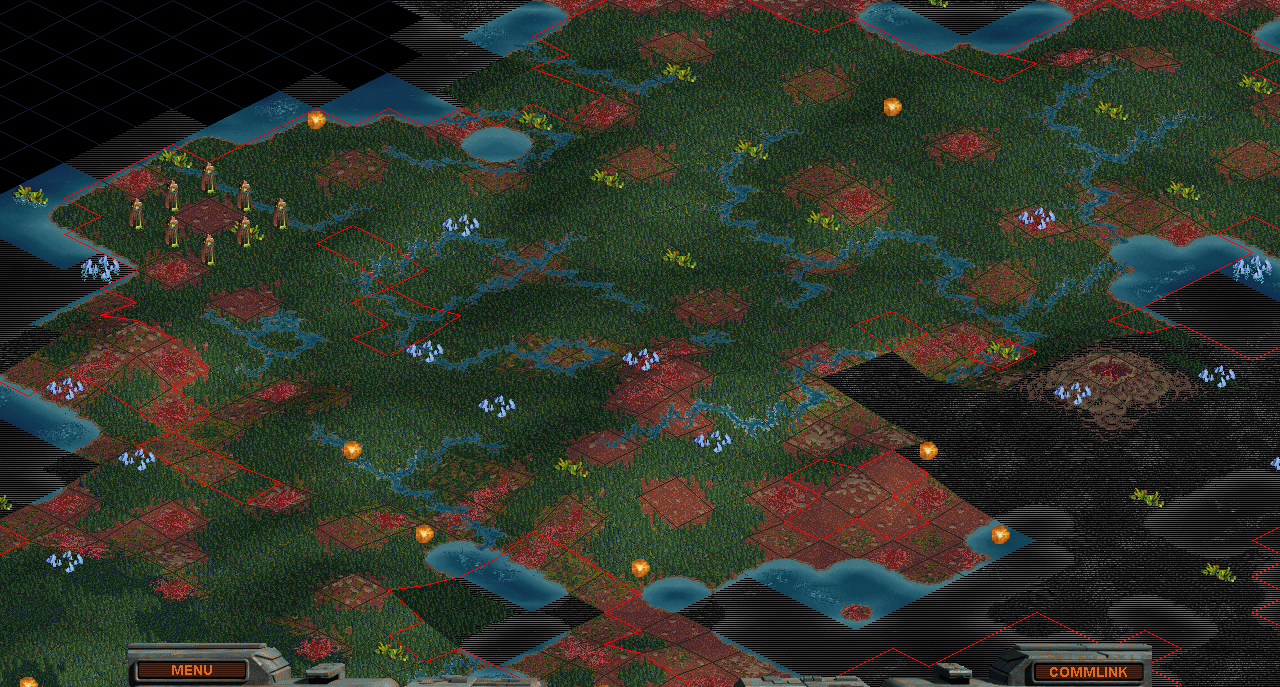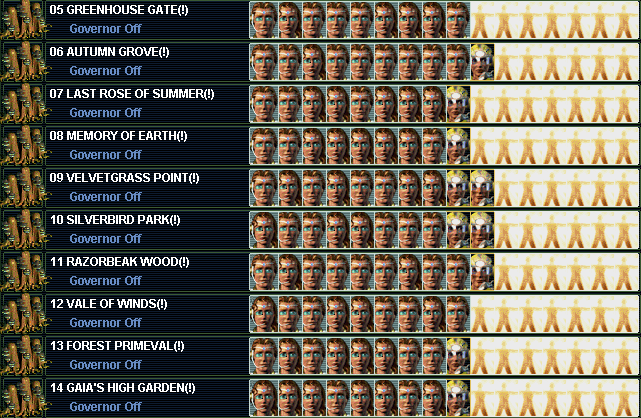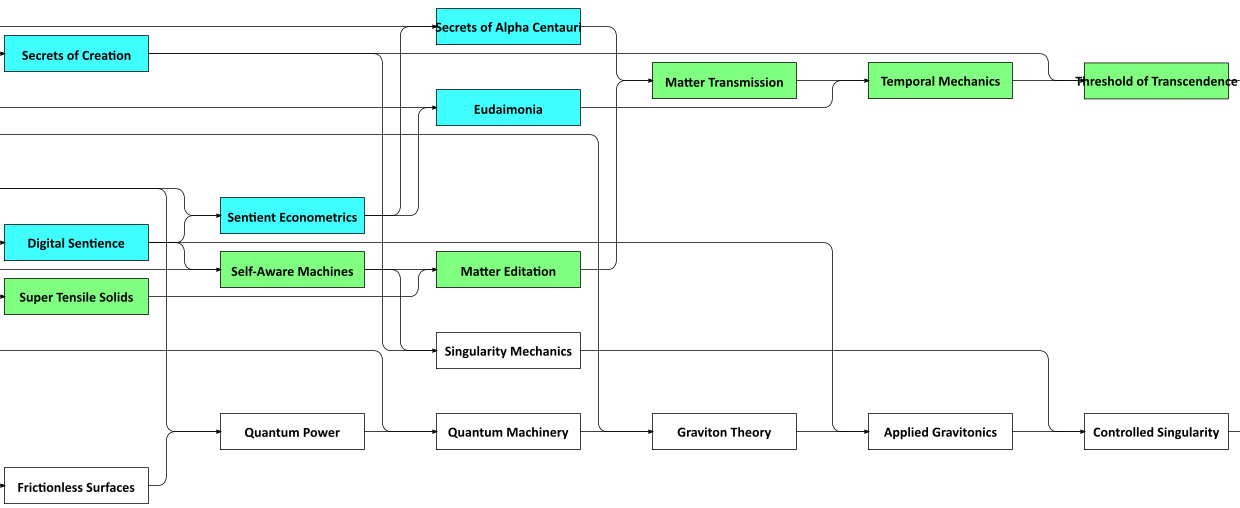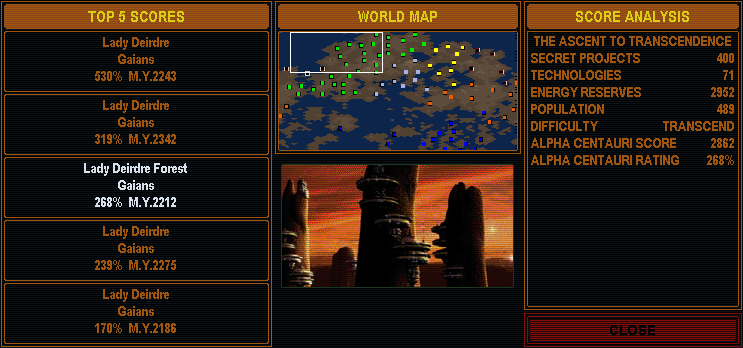Sid Meier's Alpha Centauri - Gaia's Stepdaughters

Another overview 20 turns past the previous one. Each base built its hab complex and tree farm as described, then its hybrid forest to finish booming up to maximum size (16 with the Ascetic Virtues secret project), then the fusion lab and research hospital for the science multipliers. And still along the way I reloaded every turn roll typically about 20 times looking for good forest spreads, now getting 5 or more on most turns.
Of course the tree farms were central to the strategy now, as the obvious way to massively increase food production. They were both more and less successful than I anticipated. I got more food and size from them than I'd expected; I thought the cities would run out of forest tiles and stall out on booming, but it turned out that most of them made it to the momentary max of size 14 even before the hybrid forest. But the tree farms were less successful in terms of research rate; more population is great, but when it's all working forest tiles for just 1 energy each without Free Market, it turns out that really doesn't add up to all that much.
I followed the tree farms with hybrid forests as well. I always argue against those: 240 minerals is massively expensive, and the food tends to be overkill. Just the tree farms were enough to get to size 14, and another crawler or two on fungus or forest could have reached 16 as well. But if I'm ever going to use hybrid forests, this is the time to try, so I did.

This is what almost every base looked like throughout the second half of this game. What was surprising was how many forest tiles were going unused. Each base only needed 9 or 10 to feed everything up to the max size. Now I correctly realized and can describe the effect: food improvements exhibit self-defeating behavior, same as economic multipliers in Civ 4. A base can make use of no more than 32 food at the maximum size of 16. Increasing the food productivity turns into decreasing returns as fewer food tiles can make any contribution.
What the hybrid forest really did was let me convert more population to fusion engineer specialists. Notice that an engineer is actually better than working another forest! When you don't need the food, the forest yields 2 minerals and 2 base labs at 100% slider. The engineer yields the same 2 labs, and 3 base energy, which becomes 6 after the +100% from tree farm and hybrid forest -- and that 6 energy buys more than 2 minerals. This is why you don't build for maximum city radius in this game -- cities just never need to work more than about 10 land tiles, thanks to the hard size caps and plentiful non-land sources of productivity (we haven't even gotten to orbital satellites yet here.)
And the specialists need no drone control. In fact hiring them was the only available solution to that. Each base could handle up to 9 drones with facilities and police and projects, but not more. I could manage more than that only with the psych slider, and did run 10% psych for a while, but then once all the hybrid forests were complete, I settled on this configuration as the most productive, where every citizen beyond 9 would be a specialist.
The forest tiles producing 3 energy are thanks to rivers. I used the Drill Aquifer command a lot. This is usually little use as the rivers just fall down boreholes, but here did contribute enough to be worthwhile.

Here's a view I haven't shown before: the underlying terraforming without the bases and units. (Press T in-game to cycle between a few different such views.) This clearly shows how forests covered almost all my land, plus all the rivers from aquifer drilling. Most of the non-forested squares are bases. For rocky tiles, I had formers do the Terraform Level command, then let forest spread into the square on its own. I didn't bother clearing fungus anywhere, just let forest spread into fungus tiles instead.
I thought about founding more bases, and had some idle terraformers raising some land for the possibility, but never got around to it. Such bases wouldn't catch up in productivity on their own; they would need cash rushes for at least the basic infrastructure of the creche, rec commons, network node. But I already had enough cash sinks for that in the captured jungle bases, so didn't try to extend for any more.

One detail to take care of, a bit earlier. I was worried I would start building the tree farms too soon; they raise your global tolerance for eco-damage only after you already triggered a fungus pop once. But my bases weren't damaging enough to get up over the threshold to cause that! I had to push one base to cause some damage, and Silverbird Park here was the choice, in the center of a bonus pinwheel that included three mineral bonuses. I built its hab complex sooner and gave it extra supply crawlers, to get it up to enough size and minerals to cause that fungal pop once. The tree farms would follow shortly after that and I never saw any more eco-damage the entire game.
The story of the second half of pretty much any SMAC game is the research rate. I had expected it to increase smoothly and gradually here, as every tile added was identical equally-productive forest. But the curve came out to be flatter than I'd anticipated at first, then bent upwards more sharply. My research rate had been thoroughly flat while building the tree farms, at about half a tech per turn and not really increasing. My Efficiency rating was still at a modest +2 with the Gaian faction plus Democratic minus Planned, which kept my labs slider to no better than 60%.
Completing the hybrid forests took quite a while, but then that gave the labs a sharp kink upwards. The hybrid forests themselves also provide 1 energy per forest square on top of the food, which is quite a bit, that's double the basic energy yield without Free Market in the picture. And with the fusion engineer specialists, my cash income came up to 500/turn. With that, presently in year 2189, I rushed most of the remaining hybrid forests, in the last turn I would spend with Wealth's industry discount. Then I switched to Knowledge, whose higher efficiency let me run 90% labs slider, and that combination all together nearly immediately doubled my overall labs up to just about one tech per turn.
From there, my labs rate actually exceeded the Morgan game for a while! Because these bases completed the research multipliers (fusion lab and research hospital) about five turns sooner, with all the minerals from the forests. Although Morgan would shortly get better use of energy satellites powering twice the bases and retain the lead from there.

After Fusion Power, I beelined to Digital Sentience harder than had any of the other games in this series. Didn't need Retroviral Engineering or Biomachinery. I even skipped Orbital and Advanced Spaceflight. Didn't need food satellites; energy sats would have been nice but Cybernetic was a bigger gain. And also, doing the spaceflight techs first would have delayed Digital Sentience by three techs rather than two, since it would fall into a missing-tech hole right when I needed it. Finally, the Biomachinery and Spaceflight lines also aren't needed for the next beeline to Secrets of Alpha Centauri for the legendary Transcend specialists.
As is common, Cybernetic Future Society increased my overall tech rate by 50%, from about 2400 labs and one tech per turn to 3600 and 1.5, between the maximized efficiency and direct 20% research. Some of that came because I had to convert several (four per base) engineer specialists to Thinkers instead (+1 psych +3 labs, more than the +2 of engineers), for the psych to counteract the police penalty of Cybernetic. I then did build the Network Backbone project (cheap at halved crawler upgrade cost from the Nanofactory, which was also on this beeline) which cancels the police penalty, though then just left the thinkers since they'd convert to transcends in two more turns anyway.

Amusingly, the psych from the transcends resulted in Golden Ages everywhere without even trying, thanks to all the psych multipliers. Although there wasn't anything to do to take advantage of it.
The tech path continued to Secrets of AC, Homo Superior for the Universal Translator and Nanohospital facilities, then finally Orbital and Advanced Spaceflight, upon which I did finally build some energy satellites, using all my available cash. Then I did something I hardly ever do:

Researched and adopted Eudaimonic Future Society. The bonuses look like every piece of awesomeness you could want, but for research rate it usually can't outweigh Cybernetic. But this time it did. Eudaimonic gives +2 Economy, which isn't much if you already have that from Free Market, but when you can't because you're Gaia then Eudaimonic is indeed huge. I did have to give up Planned economics in the exchange to retain paradigm efficiency, but that was fine by now. This combination did result in very slightly (about 200) more labs than Cybernetic, plus the industry bonus helped with a few energy satellites.
Shortly after that, after adding the labs-doubler secret projects in one base, my labs topped out at about 7000/turn. Short of Morgan's 11k, although still quite a bit better than I might have thought for having less than half as many bases. The real swing was Gaia having three more transcends per base thanks to Morgan's hab limit penalty.

Although this is the problem that researching Eudaimonia can cause. It is usually the last tech apart from the linear sequence marked in green here all the way up to the finish. On such a linear sequence, you can easily run into missing-tech holes. Usually Eudaimonic is an important alternative to plug a hole, but this time I didn't have that workaround. I ran into holes twice on this final beeline with no way to perturb the modulus, which costed me one turn on the finish date.

The final result was transcendence in year 2212. Only five turns behind the Morgan ICS game. It wasn't exactly a fair comparison given the luck-abuse with forest spreads; my best estimate is that gained about five to eight turns on building and supporting terraformers. But this game was decisively ahead of the original Hive finish in 2222, a difference likely mostly accounted for by the Planetary Transit System.
Thanks again for reading, and once again I may not be done here.